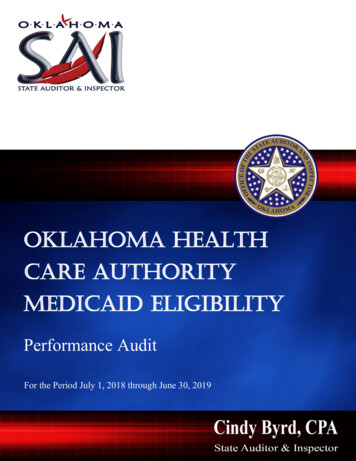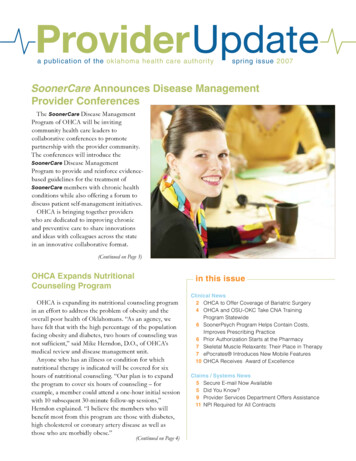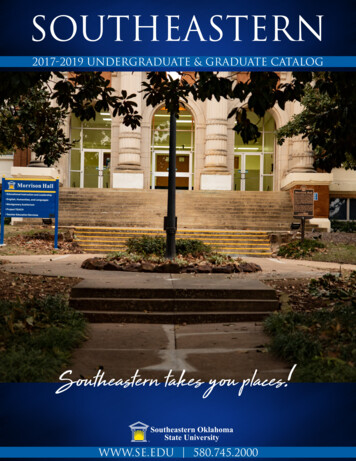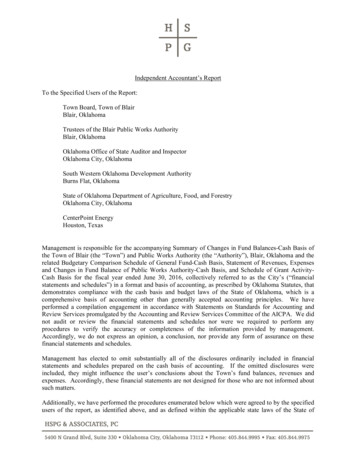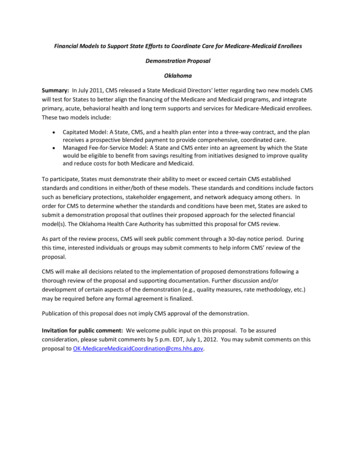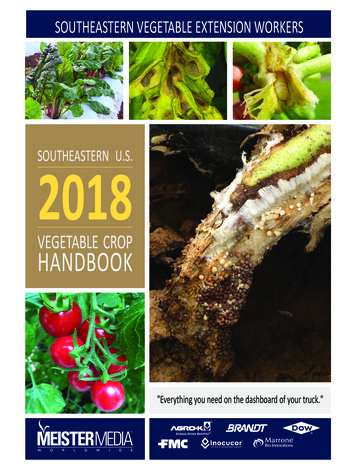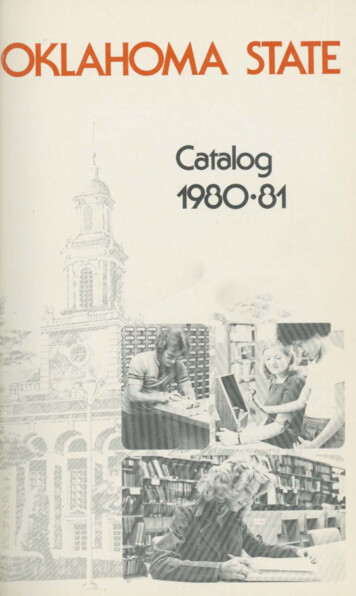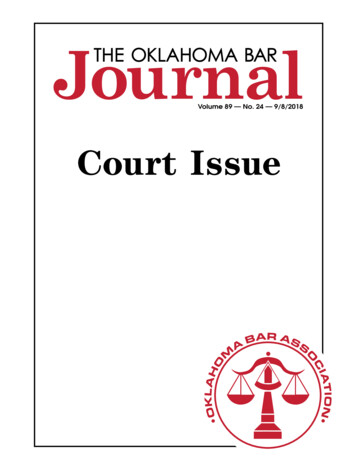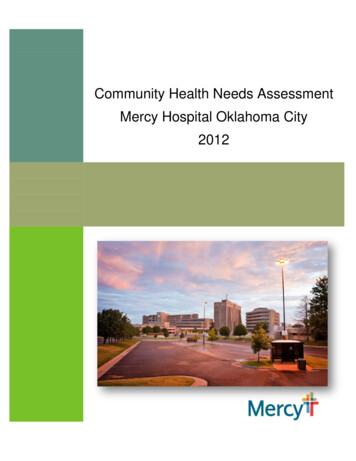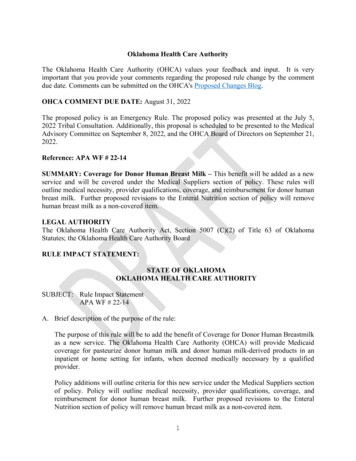
Transcription
Oklahoma Health Care AuthorityThe Oklahoma Health Care Authority (OHCA) values your feedback and input. It is veryimportant that you provide your comments regarding the proposed rule change by the commentdue date. Comments can be submitted on the OHCA's Proposed Changes Blog.OHCA COMMENT DUE DATE: August 31, 2022The proposed policy is an Emergency Rule. The proposed policy was presented at the July 5,2022 Tribal Consultation. Additionally, this proposal is scheduled to be presented to the MedicalAdvisory Committee on September 8, 2022, and the OHCA Board of Directors on September 21,2022.Reference: APA WF # 22-14SUMMARY: Coverage for Donor Human Breast Milk – This benefit will be added as a newservice and will be covered under the Medical Suppliers section of policy. These rules willoutline medical necessity, provider qualifications, coverage, and reimbursement for donor humanbreast milk. Further proposed revisions to the Enteral Nutrition section of policy will removehuman breast milk as a non-covered item.LEGAL AUTHORITYThe Oklahoma Health Care Authority Act, Section 5007 (C)(2) of Title 63 of OklahomaStatutes; the Oklahoma Health Care Authority BoardRULE IMPACT STATEMENT:STATE OF OKLAHOMAOKLAHOMA HEALTH CARE AUTHORITYSUBJECT: Rule Impact StatementAPA WF # 22-14A. Brief description of the purpose of the rule:The purpose of this rule will be to add the benefit of Coverage for Donor Human Breastmilkas a new service. The Oklahoma Health Care Authority (OHCA) will provide Medicaidcoverage for pasteurize donor human milk and donor human milk-derived products in aninpatient or home setting for infants, when deemed medically necessary by a qualifiedprovider.Policy additions will outline criteria for this new service under the Medical Suppliers sectionof policy. Policy will outline medical necessity, provider qualifications, coverage, andreimbursement for donor human breast milk. Further proposed revisions to the EnteralNutrition section of policy will remove human breast milk as a non-covered item.1
B. A description of the classes of persons who most likely will be affected by the proposedrule, including classes that will bear the cost of the proposed rule, and any information oncost impacts received by the agency from any private or public entities:No classes of persons will be affected by this rule. This rule should not place any costburden on private or public entities. No information on any cost impacts were receivedfrom any entityC. A description of the classes of persons who will benefit from the proposed rule:The proposed rule changes, regarding coverage for human donor breastmilk, will benefitpremature, ill, or babies failing to thrive. Additionally, it may benefit in situations such asadoption, foster care, a mother experiencing a physical/psychological condition, infants whomay not be able to receive their own mother's breastmilk, etc.D. A description of the probable economic impact of the proposed rule upon the affectedclasses of persons or political subdivisions, including a listing of all fee changes and,whenever possible, a separate justification for each fee change:There is no probable economic impact and there are no fee changes associated with the rulechange for the above classes of persons or any political subdivisions.E.The probable costs and benefits to the agency and to any other agency of theimplementation and enforcement of the proposed rule, the source of revenue to be used forimplementation and enforcement of the proposed rule, and any anticipated affect on staterevenues, including a projected net loss or gain in such revenues if it can be projected by theagency:Pending Budget Impact from Jimmy sent email requesting budget info and SPARC(9/6/22)F.A determination of whether implementation of the proposed rule will have an economicimpact on any political subdivisions or require their cooperation in implementing orenforcing the rule:The proposed rule changes will not have an economic impact on any political subdivision orrequire their cooperation in implementing or enforcing the rule changes.G. A determination of whether implementation of the proposed rule will have an adverse effecton small business as provided by the Oklahoma Small Business Regulatory Flexibility Act:The agency does not anticipate that the proposed rule changes will have an adverse effect onsmall businesses.2
H. An explanation of the measures the agency has taken to minimize compliance costs and adetermination of whether there are less costly or non-regulatory methods or less intrusivemethods for achieving the purpose of the proposed rule:The agency has taken measures to determine that there are no other legal methods to achievethe purpose of the proposed rule. Measures included a formal public comment period andtribal consultation.I.A determination of the effect of the proposed rule on the public health, safety andenvironment and, if the proposed rule is designed to reduce significant risks to the publichealth, safety and environment, an explanation of the nature of the risk and to what extentthe proposed rule will reduce the risk:The proposed rule should have no adverse effect on the public health, safety or environment.J.A determination of any detrimental effect on the public health, safety and environment if theproposed rule is not implemented:The agency does not anticipate any detrimental effect on the public health, safety orenvironment if the proposed rule is not implemented.K. The date the rule impact statement was prepared and if modified, the date modified:Prepared date: July 15, 2022TITLE 317. OKLAHOMA HEALTH CARE AUTHORITYCHAPTER 30. MEDICAL PROVIDERS-FEE FOR SERVICESUBCHAPTER 5. INDIVIDUAL PROVIDERS AND SPECIALTIESPART 17. MEDICAL SUPPLIERS317:30-5-210. Eligible providersAll eligible medical suppliers must have a current contract with the Oklahoma Health CareAuthority (OHCA). The supplier must comply with all applicable state and federal laws. Allsuppliers of medical supplies, equipment, and appliances must be accredited by a Medicaredeemed accreditation organization for quality standards for durable medical equipment (DME)suppliers in order to bill the SoonerCare program. OHCA may make exceptions to this standardbased on the exemptions provided by the Centers for Medicare and Medicaid Services (CMS) forMedicare accreditation, if the provider is a government-owned entity, or at a provider's requestand at the discretion of OHCA based on access issues and/or agency needs for SoonerCaremembers. Additionally, unless an exception is granted from the OHCA, all DME providers mustmeet the following criteria:(1) DME providers are required to have a physical location in the State of Oklahoma, orwithin a designated range of the Oklahoma State border, as determined by the OHCA. TheOHCA may make exceptions to this requirement if a DME provider provides a specialtyitem, product, or service, which is not otherwise available to SoonerCare members within3
the State of Oklahoma. Provider contracts for out-of-state DME providers will be reviewedon a case-by-case basis for specialty items only. The OHCA has discretion and the finalauthority to approve or deny any provider contract.(2) DME providers are required to comply with Medicare DME Supplier Standards formedical supplies, equipment, and appliances provided to SoonerCare members, except therequirement to meet surety bond requirements, as specified in 42 Code of FederalRegulations (C.F.R.) 424.57(c).(3) Complex rehabilitation technology (CRT) suppliers are considered DME providers. OnlyCRT suppliers may bill CRT procedure codes. A CRT supplier means a company or entitythat:(A) Is accredited by a recognized accrediting organization as a supplier of CRT;(B) Is an enrolled Medicare supplier and meets the supplier and quality standardsestablished for DME suppliers, including those for CRT, under the Medicare program;(C) Employs as a W-2 employee at least one (1) qualified CRT professional, alsoknown as assistive technology professional, for each location to:(i) Analyze the needs and capacities of complex-needs patients in consultation withqualified health care professionals;(ii) Participate in selecting appropriate CRT items for such needs and capacities;and(iii) Provide the complex-needs patient technology related training in the proper useand maintenance of the CRT items.(D) Requires a qualified CRT professional be physically present for the evaluation anddetermination of the appropriate CRT;(E) Has the capability to provide service and repair by qualified technicians for all CRTitems it sells; and(F) Provides written information to the complex-needs patient prior to ordering CRT asto how to access service and repair.(4) For additional requirements regarding DME providers of donor human breast milk,please refer to OAC 317:30-5-211.29.317:30-5-211.20. Enteral nutrition(a) Enteral nutrition. Enteral nutrition is the delivery of nutrients directly into the stomach,duodenum, or jejunum.(b) Medical necessity. Enteral nutrition supplies must be determined by a provider to bemedically necessary and documented in the member's plan of care as medically necessary andused for medical purposes. Requests by qualified providers for enteral nutrition supplies in andof itself shall not constitute medical necessity. The Oklahoma Health Care Authority (OHCA)shall serve as the final authority pertaining to all determinations of medical necessity. Refer toOklahoma Administrative Code (OAC) 317:30-5-211.2 and 317:30-3-1(f) for policy on medicalnecessity.(c) Documentation. All documentation submitted to request services must demonstrate, throughadequate objective medical records, evidence sufficient to justify the member's need for theservice, in accordance with OAC 317:30-3-1(f)(2). Documentation must include:(1) Diagnosis;(2) Certificate of medical necessity (CMN);(3) Ratio data;4
(4) Route;(5) Caloric intake; and(6) Prescription.(7) For full guidelines, please refer to www.okhca.org/mau.(d) Reimbursement.(1) Extension sets and Farrell bags are not covered when requested separately from thesupply kits;(2) Enteral nutrition for individuals in long-term care facilities is not separately reimbursedas this is included in the per diem rate.(e) Non-covered items. The following are non-covered items:(1) Orally administered enteral products and/or related supplies;(2) Formulas that do not require a prescription unless administered by tube;(3) Food thickeners, human breast milk, and infant formula;(4) Pudding and food bars; and(5) Nursing services to administer or monitor the feedings of enteral nutrition.317:30-5-211.29. Donor Human Breast Milk(a) Donor human breast milk. Donor human breast milk is pasteurized donor human milkwhich has been donated to a Human Milk Banking Association of North America (HMBANA)milk bank. Upon donation, it is screened, pooled, and tested so that it can be dispensed. Alldonor mothers require screening and approval by a HMBANA milk bank, and additionally, alldonor milk is logged, pasteurized, and monitored.(b) Provider qualifications. Donor human breast milk must be obtained from a milk bankaccredited by, and in good standing with, the HMBANA and be contracted with the OklahomaHealth Care Authority (OHCA) as a Durable Medical Equipment (DME) provider.(c) Medical necessity criteria. To qualify to receive donor human breast milk the infant mustmeet medically necessary criteria, which can include but not limited to the following conditions:(1) Other feeding options have been exhausted or are contraindicated; and(2) Baby’s biological mother’s milk is contraindicated, unavailable due to medical orpsychosocial condition, or mother’s milk is available but is insufficient in quantity or qualityto meet the infant’s dietary needs, as reflected in medical records or by a physician (MD orDO), physician's assistant, or advanced practice nurse; and(3) Donor human breast milk must be procured through a HMBANA entity and deliveredthrough a contracted provider, facility, or the supplier (HMBANA-accredited milk bank);and(A) Requests for coverage over thirty-five (35) ounces per day, per infant, shall requirereview and approval by an OHCA Medical Director; and(B) Coverage shall be extended for as long as medically necessary, but not to exceed aninfant's twelve (12) months of age; and(C) A new prior authorization will be required every ninety (90) days.(4) The infant has one (1) or more of the following conditions:(A) Infant born at Very Low Birth Weight (VLBW) (less than 1,500 grams) or lower; or(B) Gastrointestinal anomaly, metabolic/digestive disorder, or recovery from intestinalsurgery where digestive needs require additional support; or(C) Diagnosed failure to thrive; or(D) Formula intolerance with either documented feeding difficulty or weight loss; or5
(E) Infant hypoglycemia; or(F) Congenital heart disease; or(G) Pre or post organ transplant; or(H) Other serious health conditions where the use of donor human breast milk has beendeemed medically necessary and will support the treatment and recovery of the infant asreflected in the medical records or by a physician (MD or DO), physician's assistant, oradvanced practice nurse.(5) For full guidelines, including the medically necessary criteria, please refer towww.okhca.org/mau.(d) Documentation. All documentation submitted to request services must demonstrate, throughadequate objective medical records, evidence sufficient to justify the member's need for theservice, in accordance with OAC 317:30-5-211.20(c). Documentation must include:(1) A prescription from a contracted provider [a physician (MD or DO), physician'sassistant, or advanced practice nurse]. The prescription must include but not limited to:(A) Name of infant, address and diagnoses;(B) Parent name and phone number or email;(C) Donor human breast milk request form;(D) Number of ounces per day, week, or month needed; and(E) Prescriptions must be written on a prescription notepad and signed off by anauthorized provider.(F) For full guidelines, please refer to www.okhca.org/mau.(2) Donor human breast milk is excluded from requiring a CMN.(e) Reimbursement. Donor human breast milk is reimbursed as follows:(1) When donor human breast milk is provided in the inpatient setting, it will be reimbursedwithin the prospective Diagnosis Related Group (DRG) payment methodology for hospitalsas authorized under the Oklahoma Medicaid State Plan.(2) When donor human breast milk is provided in an outpatient setting as a medical supplybenefit, it will be reimbursed as a durable medical equipment, supplies, and appliances(DME) item in accordance the OHCA fee schedule.6
Oklahoma Health Care Authority . The Oklahoma Health Care Authority (OHCA) values your feedback and input. It is very important that you provide your comments regarding the proposed rule change by the comment due date. Comments can be submitted on the OHCA's . Proposed Changes Blog. OHCA COMMENT DUE DATE: August 31, 2022
